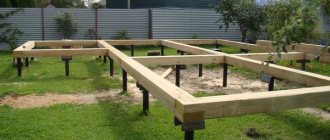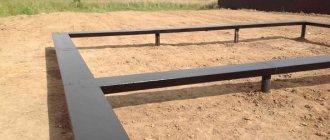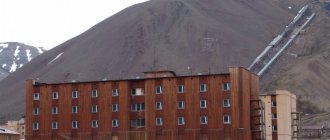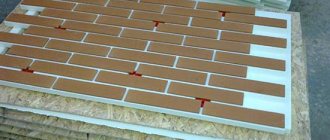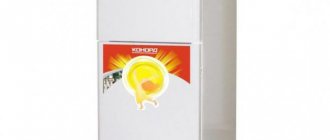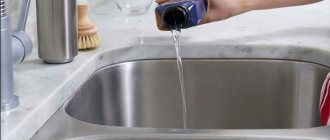In operation, the power structure is constantly exposed to the negative influence of the external environment and heavy loads, so the owners are rightly concerned about the service life of the foundation on screw piles and whether they can be used in capital housing construction.
How long can a pile foundation last?
Based on the material used, screw piles are divided into several types:
- metal rods with a blade;
- reinforced concrete screw-in pillars.
Power elements of the first type are made of steel pipes of a complicated configuration with a helical blade.
The initial data for calculating the service life of such supports are the following parameters:
- steel quality;
- pipe wall thickness;
- blade thickness;
- type of anti-corrosion coating.
As a rule, for private construction, piles with a pipe thickness of at least 4 mm and blades of 5 mm are used. During a year of operation, 0.02–0.03 mm of the metal surface is destroyed under the influence of corrosion processes.
This factor is also taken into account by manufacturers who advertise data on the service life of screw piles. Consumers can trust suppliers who sell power elements with a service life of 50–80 years. In practice, additional measures are implemented that increase the wear resistance of the pile foundation, extending its service life by 15 to 30 years.
Reinforced concrete structures are free from the main drawback of metal rods - susceptibility to corrosion processes, so manufacturers of supporting elements can confidently declare their service life to be 100 years.
Design and advantages of supports
The main feature of a screw foundation is the transfer of loads from the building to the soil through supports. The piles are constructed quite simply and consist of thick-walled pipes with welded blades, the diameter of which exceeds 120 mm.
Traditionally, screw supports were used in the construction of piers and lighthouses, ensuring the durability of the structures being built. Currently, the use of piles is common on problem soils that cannot be compressed.
Supports have many advantages:
- the ability to install and quickly dismantle regardless of weather conditions;
- completion of construction at an accelerated pace;
- use in difficult terrain conditions;
- at an affordable price.
One of the advantages of a screw foundation is its durability when carrying out activities related to special protection. Let us separately analyze the points that determine the period of application.
The weakest point of the piles is the weld seam; it is here and at the junction with the blade that rust and signs of damage appear
Durability according to GOST
According to current standards (SNiP 2.02.03-85), the operational life of screw steel piles varies between 60–120 years under the conditions that:
- pipe thickness not less than 6 mm;
- metal abrasion rate – up to 5mm per 100 years;
- development of corrosion – up to 0.5 mm in one year.
The declared service life of reinforced concrete screw supports is from 100 years. Requirements for the operation of a pile foundation are described in SP 24.13330.2011.
Is this a capital foundation or not?
Screw-in piles are capable of supporting very heavy and massive buildings or structures. Therefore, they should be considered a capital foundation by right.
In this matter, a certain psychological imbalance arises, since outwardly they do not look like a reliable support corresponding to the term “capital”.
However, the main feature is the permissibility of use in the construction of residential buildings.
This allows us to reasonably consider screw piles as a permanent type of foundation.
Why don't developers trust pile foundations?
Despite the widespread use of pile foundations, some developers are cautious about their durability. The fact is that when calculating the number of support elements, as well as their parameters, the principles and formulas set out in SP 24.13330.2011 are used.
The calculation methodology described in the documentation is based on simplified models of interaction between soil and foundation. Thus, the design does not take into account the presence of stray currents, as well as the aggressiveness of the soil and groundwater. Negative factors include the heterogeneity of the soil composition on the site. The listed aspects together reduce the operational life of the foundation for decades.
Experts advise choosing a supplier of screw piles from companies with a proven reputation, since some unscrupulous manufacturers use low-quality steel and skimp on the thickness of the anti-corrosion coating.
Which ones are most optimal for use in country house construction?
It is impossible to name the optimal type of screw piles without analyzing the soil or calculating the weight of the house.
If we proceed from the specifics of the construction, which involves the creation of a relatively light house with a small number of floors, then the most appropriate option would be to use single-bladed trunks with a diameter of 57 to 108 mm, depending on the type and condition of the soil .
More detailed information will only be provided by surveying the site and calculating the load, since the pile has a certain limit. For example, with a diameter of 57 mm, the maximum load will be 800 kg .
What can reduce durability?
Factors that have a direct impact on the service life of a pile foundation:
- Mobility of land masses. On sites with unstable soil, horizontal and buoyant forces act on the piles, which lead to deformation of the pipes and, as a result, a decrease in wear resistance.
- Seasonal temperature changes . Metal tends to contract and expand under the influence of low and high temperatures. As a result, cracks appear in the coating, where moisture penetrates, causing corrosion. If there are large temperature differences in the region where the foundation is being built, it is economically feasible to purchase piles and high-strength alloy steel.
- Agrotechnical soil erosion . The negative effect is especially pronounced in areas with hilly terrain. The action of the factor leads to local cracking of the metal surface. The presence of small stones in the soil that scratch the outer coating increases the rate of destruction.
- Chemical corrosion . In soil with a high acidity level, rust formation occurs faster. The problem is solved by sandblasting the rod before immersing it in the soil.
- Exposure of metal to an electrically conductive environment . Currents wandering in the soil increase the rate of metal oxidation. Foundations next to which cables or industrial facilities are laid underground are more susceptible to negative effects.
- Failure to comply with transportation and storage rules, as well as violation of installation technology. The listed aspects lead to damage to the surface of the piles and thereby reduce the degree of protection from many external factors.
The service life of reinforced concrete screw piles depends, first of all, on the quality of the concrete used, as well as compliance with production technology. Such a foundation will last more than a hundred years if the permissible loads are correctly calculated and the alignment of the load-bearing elements at the same level is observed during the process of screwing into the ground.
For what buildings is it needed?
Screw piles can be used for various buildings. World practice has shown the ability of this type of foundation to successfully work with massive, heavy and tall buildings and structures.
However, in Russia the technology for creating this foundation has not yet been developed, so they are usually limited to the construction of auxiliary or outbuildings. For residential buildings, screw piles are used reluctantly and quite rarely.
How to extend operation?
To extend the service life of a pile foundation, owners should pay special attention to the quality of structural elements, as well as carry out a number of additional measures during installation work:
Selecting piles from high strength steel . If a geological analysis of the soil shows that the site has very aggressive soil, then it makes sense to choose pipes with a wall thickness of at least 5 mm. An increase in the indicator by even 1 mm will increase the service life of the foundation by several decades.- Power elements made of alloy steel . This material compares favorably with its performance characteristics compared to conventional metal. The high cost of such piles is offset by the increased period of operation of the foundation.
- Coating with an additional layer of anti-corrosion protection. Despite the declared quality and wear resistance of supports treated with hot-dip galvanizing, this protection option does not work well in the event of destruction occurring directly in the ground. To protect the foundation from electromechanical and chemical corrosion, experts advise covering the metal with an elastic layer of material based on epoxy resins, polyurethane, etc.
- Concreting screw piles. This is the simplest and most effective method of increasing the service life of supports. Concrete poured into the internal cavity of the pipe displaces all oxygen, eliminating the risk of oxidation and, as a result, destruction of the pile from the inside.
Builder tips
If you want to increase the service life of a screw foundation, adhere to the following recommendations:
- Do not purchase supporting elements from unverified manufacturers who sell low-quality piles at low prices.
- Pay attention to the presence of a certificate of conformity, which guarantees the use of high-quality materials, compliance with technology and the durability of the supports.
- In winter, refrain from installing supports that may become loose after the soil thaws.
- Carefully fill the internal cavity with concrete mortar, maintaining the coating and without creating additional stress.
- If necessary, restore the piles, which will also extend their service life.
- Treat the inside of the support with protective coatings, along with the working surface.
Answer
Leave your tips and comments below. Subscribe to our newsletter. Good luck to you and good luck to your family!
- Question: Can a water well casing be used as a ground electrode?
- What is and how to do zeroing
- Question: We need a staircase to the second floor, there is not enough space
- What kind of foundation for a garage should be made from FBS blocks?
- How to insulate a bath
- What is the minimum slope of a gable roof for normal snow melting?
- How to make, build a fence from corrugated sheets with your own hands
- How to build a 10x20 m garage from a met sandwich. frame?
- Question: Which roof design is best for an extension?
- Question: There is no ventilation in the apartment, how can I do it?
- Load on the septic tank lid from cars passing over it
- Question: How to repair and insulate a roof
- How to navigate by the stars and moon
- Question: About waterproofing and flooring in a cellar on the river bank
- Vegetable storage in the basement (raise and insulate the walls, arrange ventilation)
- Siding frame for a house made of foam blocks
This can lead to accelerated wear of the piles due to increased corrosion, especially if there are current leaks to the ground. It is better to arrange a separate grounding.
Comparison with other options
Only knowing all the advantages and disadvantages of the pile-screw structure, as well as the features of strip foundations with the pros and cons of the technology for constructing and operating the building fixed on it, can you make the right choice. The strip base is characterized by:
- possibility of shallow laying on dry, non-heaving soils;
- convenient arrangement of the burial space;
- the opportunity to do everything with your own hands;
- it takes a certain time for the concrete solution to completely cure;
- used to strengthen brick and concrete buildings;
- a significant increase in costs for areas with severe soil freezing.
It should be noted that the arrangement of a strip base in the cold season is accompanied by an increase in labor intensity and costs.
Strip base Source nl.decorexpro.com
There are several other types of foundations based on the use of piles, which are popular in individual construction.
Pile-tape construction
The most advanced option is considered to be a pile-strip foundation, the pros and cons of which reflect its effectiveness in the most difficult cases:
- for a building made of brick or reinforced concrete structures;
- mobile heaving soils;
- groundwater, high humidity;
- difficult terrain, slope.
Pile-strip foundation Source vologdadom.com
Piles are installed to a depth of up to 2.5 m, which ensures increased reliability and stability of the foundation of the house.
Reinforced concrete piles
The construction of a house in areas with problematic soil, including coastal areas, steep slopes, peat bogs, deep freezing, is carried out on a foundation on reinforced concrete piles, its pros and cons are as follows:
- design work is complex and must be performed by a professional;
- allows you to obtain the maximum possible stability and rigidity of the foundation;
- suitable for heavy buildings;
- high cost of materials and work;
- use of specialized equipment.
Piles made of reinforced concrete Source svoisvai.ru
The length of reinforced concrete piles reaches 11 m. In private construction, elements about 3 m long are used, which weigh at least 700 kg.
House on a pile-screw foundation Source kursremonta.ru
Selection of construction site
The location of the construction site is determined in accordance with the purpose of the building being constructed and the type of its structures. The construction site is selected without the presence of ice and the absence of flood waters.
Plots of land located at the foot of the mountains are often saturated with ice, swelling of heaving soils and deep veins of ice. On gentle slopes such phenomena are not observed. Such areas are most suitable for construction.
To assess the suitability of a site for construction, a geodetic survey is carried out. They also take pictures of the surrounding area. This will allow us to paint the whole picture of the direction of natural water flows, the possibility of their drainage and the installation of sewer channels.
